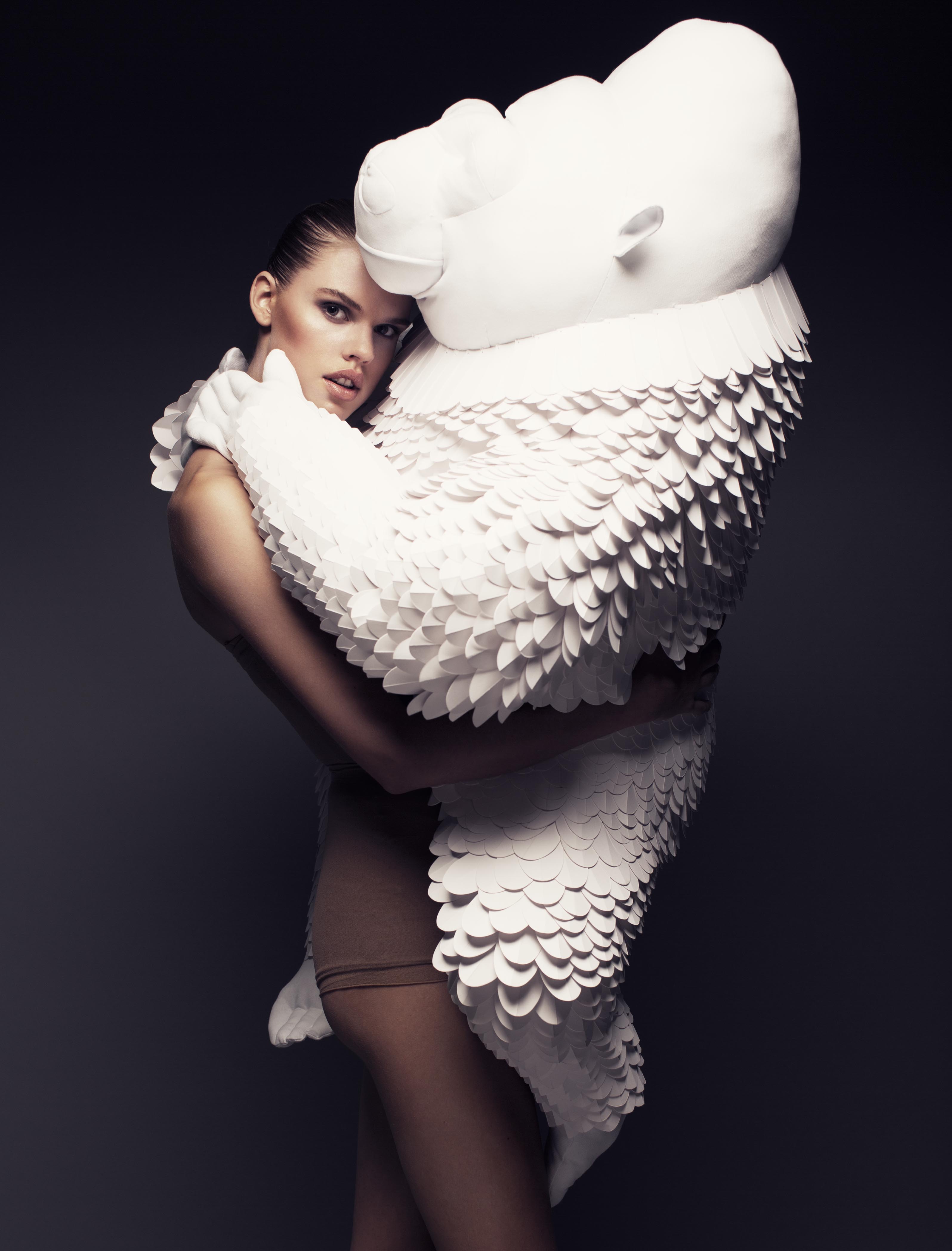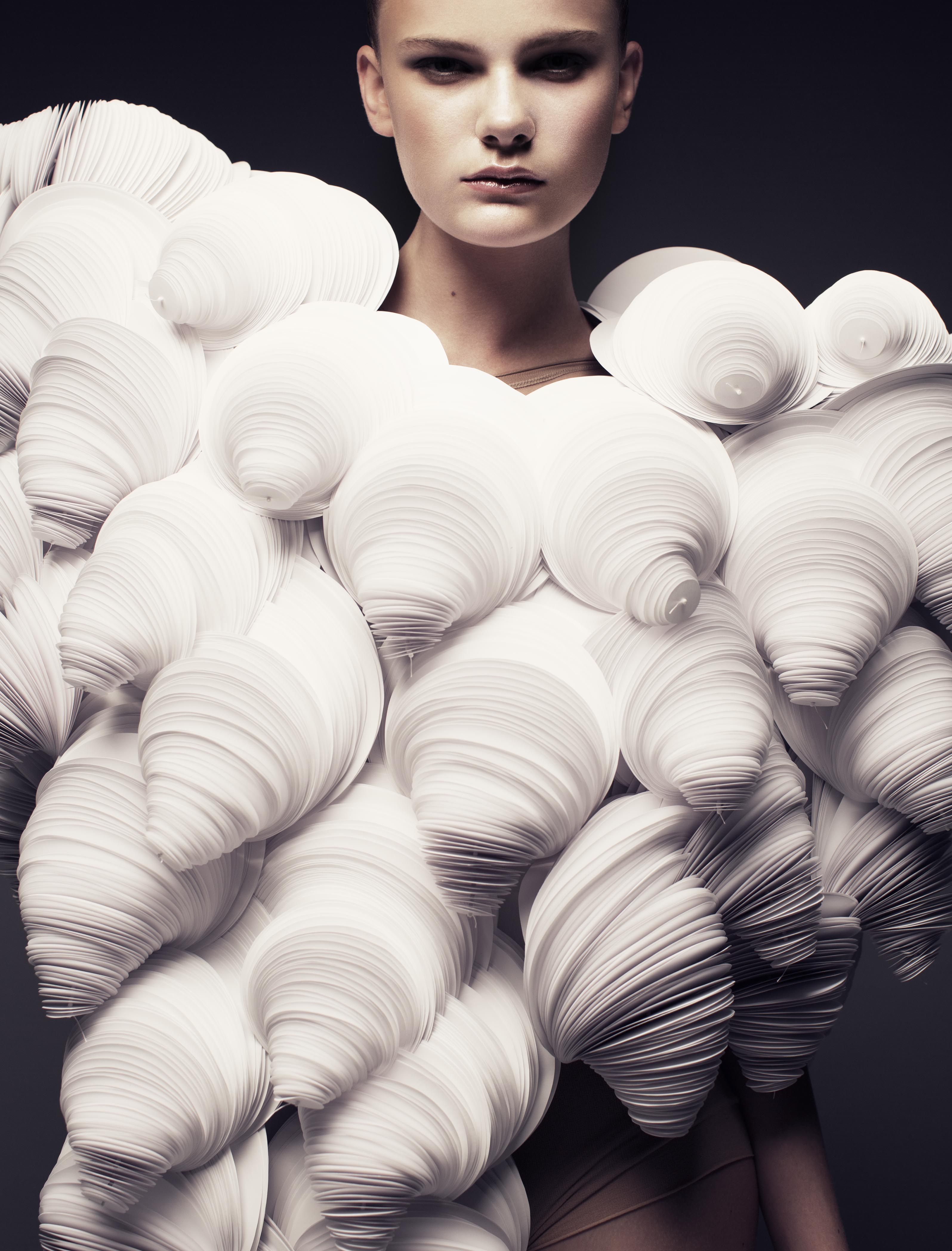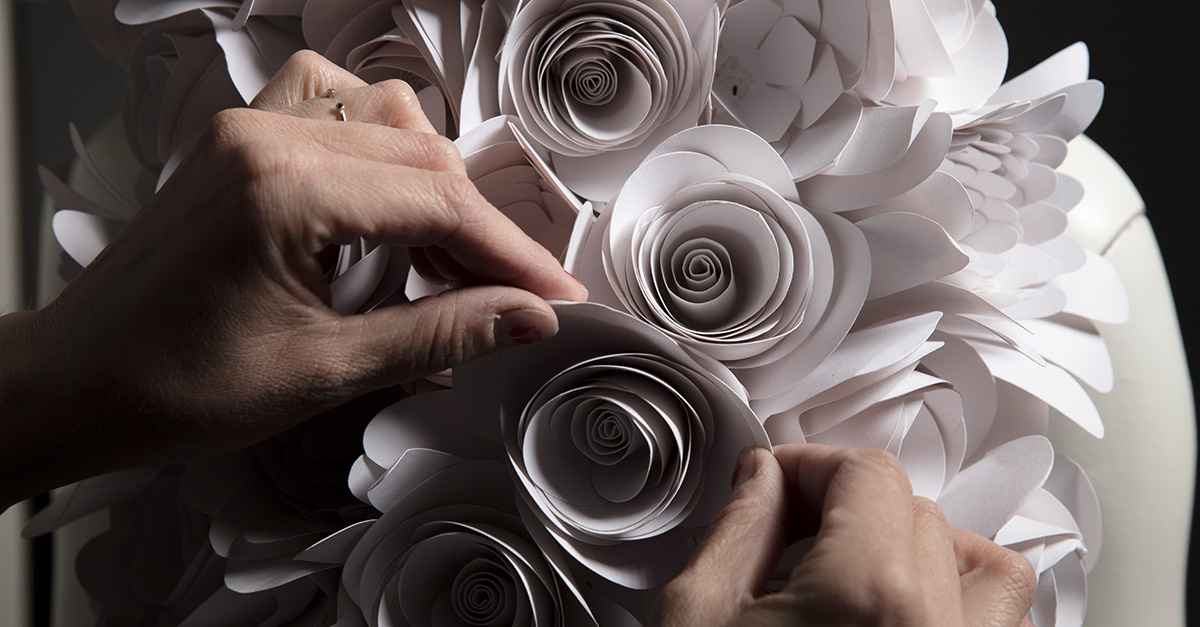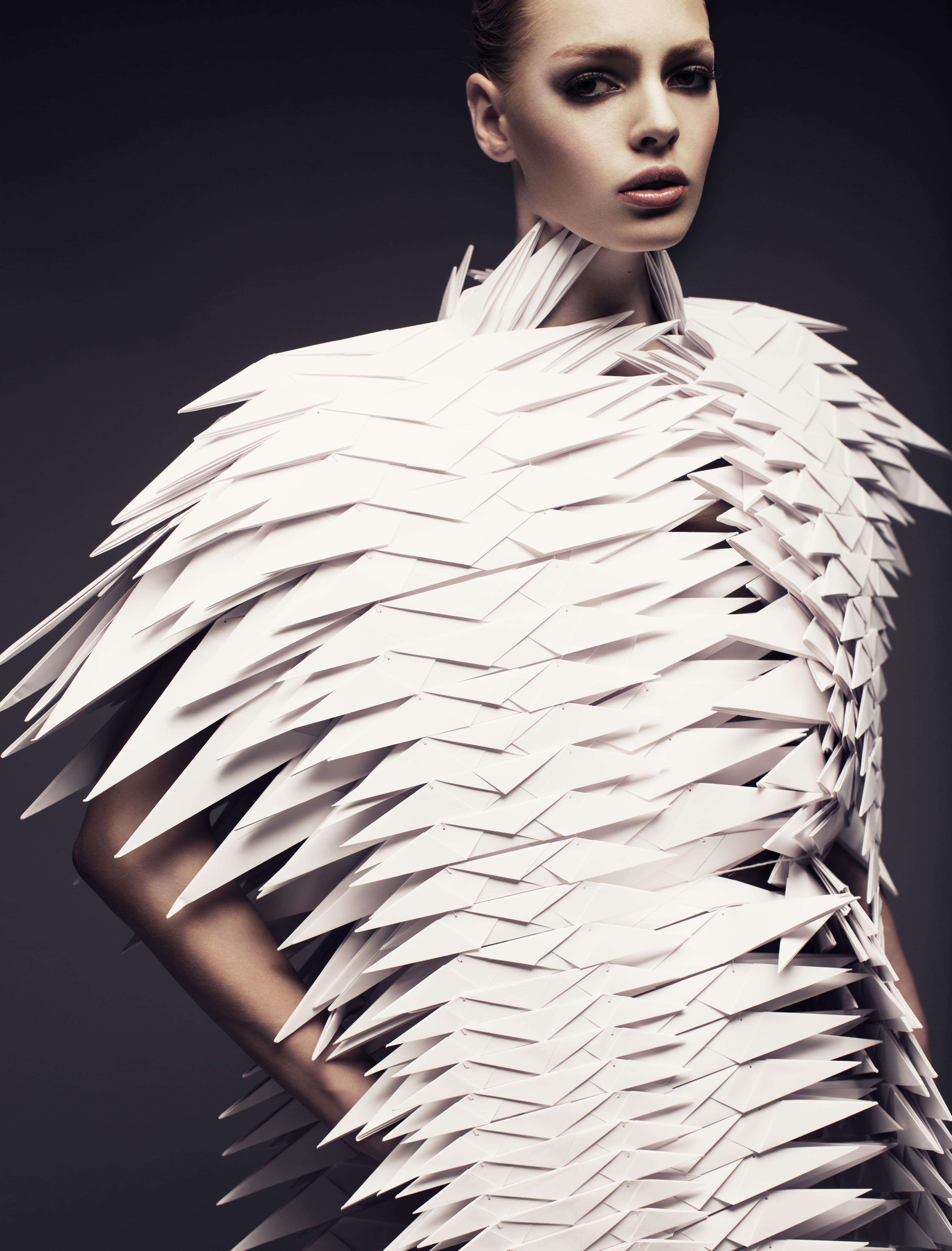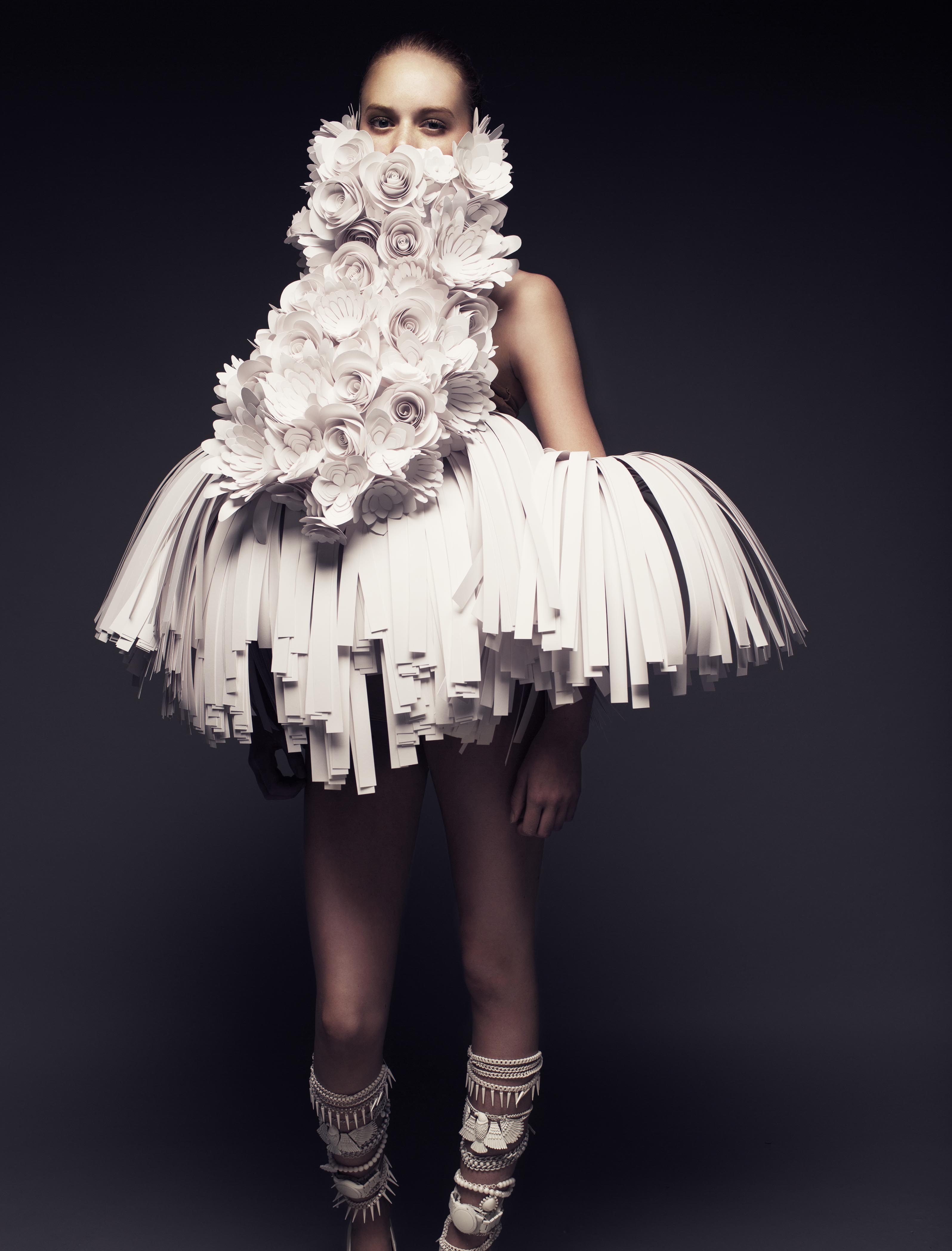
The future is handmade
Art and culture are excellent ways to turn given concepts upside down, and create new approaches and solutions. One avant-gardist, who does not fear new paths, is artist and designer Bea Szenfeld. She is the trained potter who’s giant paper dresses now can be found on celebrities, at the Nobel prize ceremony, in fashion magazines and in museums. We met with her to hear her thoughts on exploring new materials – and how she came to fell in love with paper.
Art, paper, scissors
Bea Szenfeld, has always felt an urge to express herself through different types of mediums and materials. She is a trained potter, cutter and fashion designer and has done her trainee at Stella McCartney’s. But she felt out of place working with fashion, and experienced that she came too far away from what she actually loved.
– After my training and education in fashion and design, I started my own brand of clothes, says Bea Szenfeld. But I noticed after some time that the majority of my time was spent on dealing and trading with textiles, or with marketing – and that was not my forte. I love design, and I love the human body. So I started doing some small projects on the side, where I had a more artistic approach to the human form and figure. That is when I began to do clothes in other material than fabric. And I noticed that when I did a dress out of salad or pasta, the focus shifted from “can I get this in another size?” to “oh, this is design – a new way of dressing the body and contouring silhouettes!”.
During this period, Szenfeld describes, she did many trials and errors with different materials, but quite soon discovered the simplicity with paper.
– I did some tests in paper, and thought “this is too good to be true!”, Bea Szenfeld laughs. It was incredibly simple, and paper is such a beautiful material. It's such an easy job, once you play in its league. Once you have learned paper, it is truly so gratifying!
Heavy light-weight
Even though Szenfeld has found her core material, it is still an explorational journey for her creations. Most often, it is the practical conditions that limits the creative possibilities in her work. Despite the light weight material, Szenfeld’s creation are surprisingly heavy, and sometimes hard to transport. Therefore, the garment is shipped in disassembled pieces – and then reassembled on a model when in use.
– The garments I make can often break in shipping or handling, and many of my pieces weigh over 20 kg, Szenfeld explains. So I have found a way to store and transport these creations in small pieces, where I instead dress on every single garment. I build these sculptures and assemble them one by one. Paper can withstand quite a lot, but not too much. Therefore, you need to trick the eye, and also the paper, a little. If I cut a little cardboard and a little tissue paper in between, I can trick the eye into thinking "this feels fragile", but still it is a support in the form of the solid cardboard.
Szenfeld has, with her experimental creations and unusual concepts, proven that sometimes you don’t need to label what you do. You just need to do. Her pieces really leaves no one unimpressed, and that is the intention. A common denominator in her work is emotions – and humor.
– Yes, humor is very important! Szenfeld laughs. I really try to be serious, but despite that, when I had my fashion show in 2015, people laughed when my models came out. Because "here comes the model carrying a 200-kilo gorilla like a handbag". I believe that fashion needs to be paused a bit, because it gets ridiculous when it gets too cool.
 "I believe my strength has been that I have never been still. I am constantly testing my way forward." Bea Szenfeld, artist & designer
"I believe my strength has been that I have never been still. I am constantly testing my way forward." Bea Szenfeld, artist & designer
Sustainable fashion
As recent times have shown, we need to rethink and challenge given frameworks to find a more durable way forward. Even though the art pieces requires a lot of material, the resources used are environmentally friendly, and most definitely circular.
– I work with plain paper, no special treatments on it or anything, Szenfeld explains. Plain paper, directly from the paper mill here in Sweden. The great thing about paper is that we have been producing and recycling paper for so, so many years. It is one of the oldest materials we reuse, which means that it is not rocket science - we know this, we know how to manage this resource.
All surplus and waste pieces from the art objects can be put straight in the paper recycling. Since no materials are mixed, everything can be pulled apart and recycled or reused. When the lifespan of a garment is finished, the threads are removed and the glass/plastic beads are reused. The paper is just put in the recycling bin. It really is circular art. And for the garments that still lives on, depending on the storage and treatment it can really be long lasting.
– My paper sculptures can be stored and kept for as long as you like, it all depends on how you handle them, Szenfeld explains. They cannot be exhibited in direct sunlight or in a humid room, but if they are handled by me or museum staff, they last for decades.
Different target groups
Apart from exhibiting her art at museums and in fashion magazines, Szenfeld is also a recurrent feature in one of Swedish Televisions most watched TV-magazines, Go’kväll (Good Evening). There she has a standing mission on a reoccurring basis, a DIY-project that is either recycled or upcycled.
– I love those projects, Szenfeld smiles. I have about 7 minutes to show a DIY-craft that people can do themselves at home. In those projects, I find that lamps and luminaires are among the best things to use. You can do simple things and it is always needed at home. And especially now with LED lighting, when the light source does not get hot, the possibilities are so much more and vivid! It really enables you to work with more recycled materials than previously.
Yet another aspect regarding the material is that people from so many different target groups can relate to it. Everyone from pre-schoolers, craftsmen, designers or engineers – they all enjoy the magic and illusions created with regular paper.
– That is truly one of the things I love about my paper clothes, that I can float out without a straight horizon, Bea Szenfeld says. If you like art, you may like my stuff. If you like fashion, you can like my stuff. When I exhibit in cities with paper or forest industry, there are usually visitors who work with paper - who have never seen it used like this. They might work with cardboard and large sheets, and so all of a sudden they see how their material can become something completely different. And those who love crafts, the same thing. You can do so much with paper, scissors, a ruler and some time - it's completely crazy! It's really lovely to find entrances to so many different audiences.
Tabula rasa
So, how does the future looks like for art in general, and more sustainable art in particular? Is there a visible trend for designers and artists to work more circular?
– Yes absolutely! Szenfeld states. I am part of the jury in Ung Svensk Form (Young Swedish Form) and at least half of all projects that contribute are about recycling and reusing. Either they reuse materials or create designs that are easy to reuse.
Not only is sustainability a high awareness among the upcoming artists and designers, so is also the love for crafts and handmade work.
– I love that, but we craftsmen must never relax and think that “this is good, now crafts are in", Szenfeld says with emphasis. We must always fight for recognition, and the time we spend. What we do is not a quick fix, a craft takes time to learn. That's something we need to explain to the new generation, that you have to take time with things. Now we have a world that spins so incredibly fast. From one day as unknown, to another day as world-famous on TikTok. That was not the case before, then you had the chance to grow up a little cautiously. Crafts are really slow techniques, and that is the way it must be.
Fact on Bea Szenfeld:
- She is trained potter and cutter, as well as graduated from Beckmans School of Design.
- After participating in Project Runway, she earned her internship at Stella McCartney.
- Has dressed celebrities such as Lady Gaga, Björk and Loreen.
- Designed the Swedish minister of Culture Alice Bah-Kunkhe’s dress for the Noble Dinner.
- Has explored other materials as well, and made a dress out of pasta for Barilla and clothes entirely of PVC.
TEXT MARIA VÅRENIUS
FOTO EA CZYZ, JOEL RHODIN
Relaterade nyheter

Fagerhults vårdrumspaneler är godkända för Medical Device Regulation
Fagerhults vårdrumspaneler är nu godkända för den nya medicintekniska förordningen MDR. ”Vi ser nyttan av att våra kunder redan nu kan erbjudas produkter som är anpassade för framtida krav,” säger Lars Handberg som är teknisk produktchef för medicinska försörjningsenheter. Det gamla medicintekniska direktivet MDD, Medical Device Directive, har ersatts med nya förordningen Medical Device Regulation, förkortat MDR. Övergången bland leverantörer måste ha skett senast den 31 december 2028. Fagerhult börjar leverera sina vårdrumspaneler enligt MDR redan nu. ”Fagerhult påbörjade tidigt arbetet med att säkerställa dokumentation och processer enligt den nya förordningen MDR. Följden är att Fagerhults vårdrumspaneler redan nu uppfyller MDR 2017/745 artikel 22”, säger Lars Handberg. Img Som en konsekvens av detta utgår den klassiska CE-märkningen. Anledningen är att vårdrumspanelerna enligt förordningen – i det fall man väljer att följa artikel 22, modulsammansatta produkter – inte ska vara försedda med ytterligare CE-märke, (artikel 22, punkt 5) eftersom ingående komponenter redan är CE-märkta. ”Det här är inget som påverkar produktens funktionalitet eller säkerhet utan är en följd av lagskrivningen. Fagerhults vårdrumspaneler följer produktstandarden och är lika säkra som tidigare. Däremot kan det vara bra att känna till, om någon skulle reagera på att CE-märkningen inte längre sitter med på de nya produkter som levereras.”, säger Lars Handberg.
Vi sluter cirkeln och förlänger armaturernas livscykel
Det blir allt vanligare att bygga om gamla armaturer för att spara material och energi. Ibland är kärlek och tekniska kunskaper det enda som behövs för att en sliten gammal armatur ska lysa igen. Vi träffade Emma Hallman, Mathilda Holl och Andreas Ekslätt, teamet bakom ReLight på Fagerhult, för att diskutera utmaningarna med att hitta lösningar som gör det möjligt att återanvända gamla armaturer. Fagerhult genomsyras av en innovationskultur som påverkar alla aspekter av arbetet. Möjligen kommer den från grundaren Bertil Svensson, som ofta löste problem med små medel, i kombination med nyfikenhet och entusiasm. Men på den tiden var hållbarhet inte direkt något buzzword. Att använda jordens resurser på ett medvetet sätt och eftersträva hög kvalitet har dock alltid varit viktigt för Fagerhult. Idag finns ett nytt fokus på cirkularitet som tvingar oss att utmana invanda föreställningar och hitta långsiktiga lösningar. Fagerhults avdelning Bespoke Lighting Solutions (BLS) har utvecklat unika armaturer och anpassade lösningar i många år. Att renovera och uppdatera gamla armaturer är alltså något vi kan. Att återanvända och bygga om gamla armaturer för att minska klimatpåverkan har dock blivit en allt större del av vår verksamhet. I denna process uppgraderas gårdagens design och teknik utifrån dagens kunnande för att möta morgondagens krav. Citat ReLight – ge dina gamla armaturer nytt liv För ReLight-teamet på Fagerhult finns det inga konstiga frågor eller omöjliga lösningar. Varje dag tar de emot förfrågningar om specialutvecklade belysningslösningar för projekt på Fagerhults marknader. Det är en komplicerad process, men med tiden har de lärt sig att det i vissa projekt är bättre att återanvända gamla armaturer istället för att investera i nya. – För oss är armaturens kvaliteter i ljuskomfort, säkerhet och estetik kärnan i varje ReLight-projekt. På begäran räknar vi även ut om – och hur mycket – vi kan minska armaturens totala klimatpåverkan under hela dess livscykel.", säger Emma Hallman. Inom ReLight finns en uttalad vilja att spara material och energi – och göra en insats för miljön genom att uppdatera armaturerna. Alla gamla armaturer kan dock inte leva för alltid. Vissa är föråldrade och dem är det bättre att återvinna än att renovera. Img – Om omständigheterna inte uppfyller våra krav och armaturen inte kan byggas om går vi inte vidare med projektet. Vi skulle aldrig kompromissa med ljuskomfort, kvalitet, säkerhet eller armaturens utseende om det inte resulterar i en lösning av hög klass, säger Emma Hallman. På Fagerhult är säkerhet och kvalitet den röda tråden som är gemensam för alla produkter. ReLight är inget undantag. CE-märkning och testning är mycket viktiga delar av processen. – För att säkerställa den övergripande kvaliteten är den uppdaterade armaturen CE-märkt i sin helhet innan leverans. Vi vill också göra installationen på plats både smidig och snabb och det nya kitet är så nära en komplett armatur som möjligt, säger Andreas Ekslätt.
